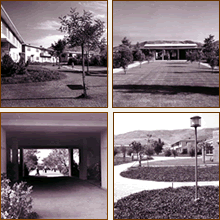History
The design is the result of a successful collaboration between architects and landscape architects. The architectural team included Reginald Johnson and Merrill, Wilson and Alexander, associated architects, with noted American urban planner Clarence Stein as the consulting architect. Fred Barlow was the original landscape architect. Stein considered Baldwin Hills Village the most fully realized example of his "Radburn Idea", which was his adaptation of British Garden City idealism to the American Environment. For Stein and other Garden City designers, providing green space in close proximity to living units promoted social well-being within a planned community. Thus the Radburn Idea envisioned communities organized into "superblocks" that relegated vehicular traffic to the perimeter and focused living units toward interior shared gardens and lawns, as well as child-friendly walkways and play spaces.
Soon after construction the site was recognized by the AIA for its design quality. It was declared a City of Los Angeles Cultural Heritage site in 1977 and a National Register property in 1993. Village Green became a National Historic Landmark in 2001.
Over time, some changes have occurred in the landscape. However, many of these changes have been documented, and the essential character of the site thus far has been retained. The "as planted" drawings by Fred Barlow from 1942 are in the Village Green archives, although the plant list was lost. The record is sparse for changes made from 1940 until 1963. In 1963, the Baldwin Hills Dam broke and the site was inundated. Landscape architect Merrill Winans developed another landscaping plan with different goals and objectives. Much of the tree landscaping was retained but with additional species and plantings. The shrubbery was changed significantly with a new esthetic and different species. Village Green Owners Association also has these landscape plans, dated 1966. Between 1966 and 1995 changes were made on the basis of plant preferences without reference to historic plans. In 1995 Village Green developed a Master Plan; however, it was not fully directed toward cultural landscape preservation and thus has limited usefulness for preservation. Currently, Village Green has excellent landscape consultants, but without long range comprehensive planning and analysis, their task is almost impossible.
The Village Green Owners Association recognizes that its designed landscape is integral to its heritage as well as to its National Historic Landmark status. In addition to creating a CLR report, the association has also voted to adopt the Secretary of the Interior's "Guidelines for the Treatment of Cultural Landscapes". The recent formation of Friends of Village Green, a 501(c)(3) preservation organization, will open opportunities to obtain grants to help document, recognize and preserve this legacy.
Village Green is fortunate to have good local and regional preservation organizations that can offer guidance. It is a member of both the California Preservation Foundation (CPF) and the LA Conservancy. Village Green sends members to the annual CPF Conference, which provides a valuable opportunity to meet other people and organizations working for preservation. Village Green has had regular contact with the University of Southern California's Program in Historic Preservation, and some of the USC faculty members have taken an interest in Village Green projects.


